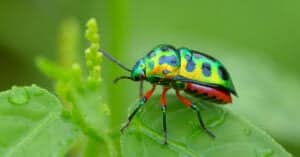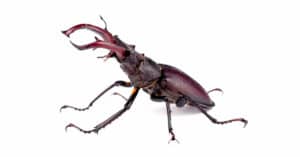The beetle is among the most diverse insects in the world. There are more than 400,000 known species belonging to the insect order of Coleoptera. Some of the species eat wood, some fly through the air and light up the night sky, and some fight each other with large horns protruding from the head. The one defining feature that unites together most beetles is the front pair of wings enclosed in a hard case. This wing case is called the elytron. When it wants to fly, the beetle opens up the wing case and exposes the front wings.
Beetles are also defined by their ability to through a four-stage life cycle: the eggs, the larva, the pupa, and the final metamorphosis into an adult. This entire process can take anywhere between a few months and several years to complete; wood-boring beetles tend to have a particularly long lifespan sometimes lasting up to a decade. When the temperature drops, the beetle can “overwinter” at any stage of the life cycle. Overwintering is a process in which they find a secluded or warm area to survive the winter. This article will cover some interesting facts about the entire life cycle of the beetle.
The Egg Stage
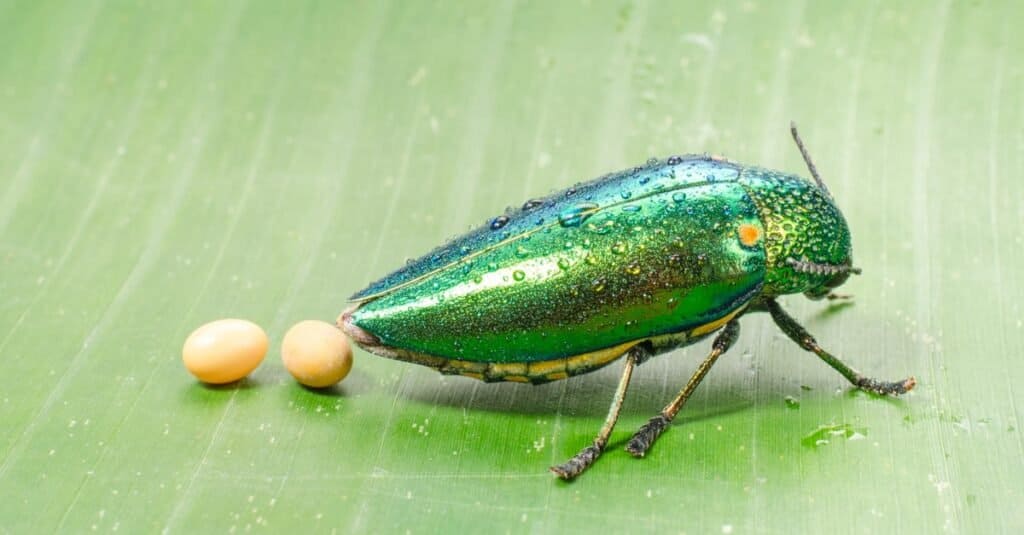
©pattara puttiwong/Shutterstock.com
The beetle’s reproductive season usually takes place between the spring and autumn months. Many species use chemical pheromones to locate their mates; others use sounds or visual signals such as light. When access to mates is limited, the competition between males becomes quite fierce as they vie for the attention of the females. Males have evolved various strategies to give themselves the best chance to pass on their genes. However, all this sexual competition isn’t for everyone; some species have the ability to mate asexually without a male. The facts behind this process aren’t well understood yet, but they usually combine sexual and asexual reproduction together. It’s very rare that an entire species can survive and reproduce entirely through asexual means.
Once they’ve completed the mating process, the mother will tend to choose the same habitat she was raised in to produce her offspring. She will lay her eggs directly on the source of food, whether it’s wood, plant leaves, feces, or a place with sufficient prey. She may lay a few dozen to a few thousand eggs during the course of her adult life. These eggs can come in a variety of different colors, but they’re usually hard, smooth, white, or yellow. Their size is so small that identification can be somewhat difficult with the naked eye. The eggs usually hatch after just a few days but may also spend months in this form depending on the life expectancy of the species. A few species keep the eggs inside of them and give birth to live larvae instead.
The Larval Stage
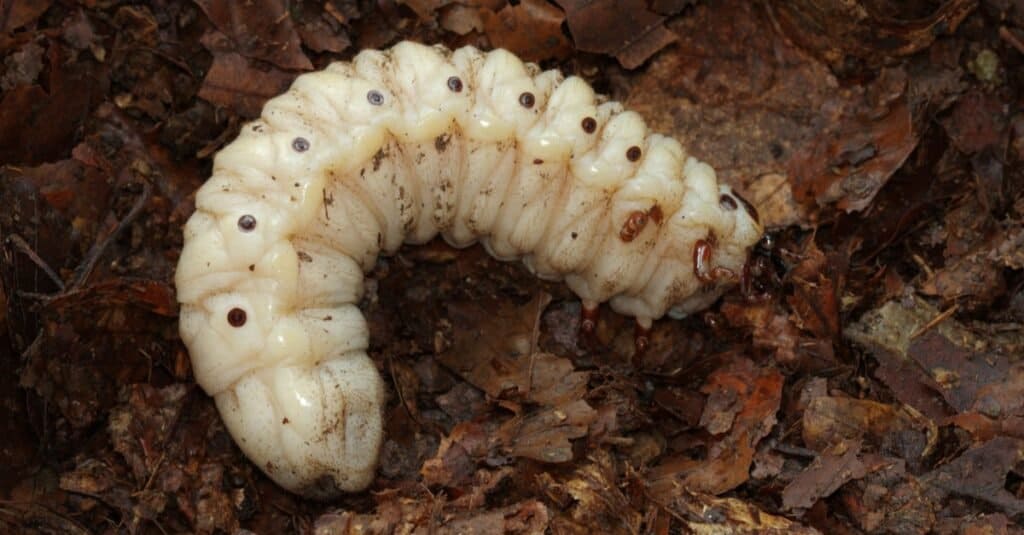
©Petr Muckstein/Shutterstock.com
The larval stage, also known as the grub, is usually the longest-lasting and most important part of the beetle’s lifespan. Identification is fairly easy. It has a big worm-like appearance with a long, segmented body, sometimes colored white, and small or non-existent legs and wings. With their large mandibles, they do most if not all of their feeding in the larval stage to grow rapidly in a short span of time. Their habitat is the same substrate on which the eggs are laid. Some species are specialized for the cellulose of wood, others feed on plants exclusively, and many are at least partially predators in nature. Some beetles form a symbiotic relationship with fungi. The adults spread and cultivate the fungi as a food source for the larvae to feed on.
As they begin to feed and grow larger, the larvae will molt or shed the outer exoskeleton covering of their bodies. Each separate stage in between successive molts is known as an instar. Three instars are the most common number of molts, but some species can pass through as many as 10 instars before the larva is done growing. Depending on the species, the process can take as little as a few weeks and as long as several years in their life expectancy. By the end of this stage, the larva has eaten so much that it grows to be just as big if not bigger in size than the adult it is destined to become.
The Pupa Stage
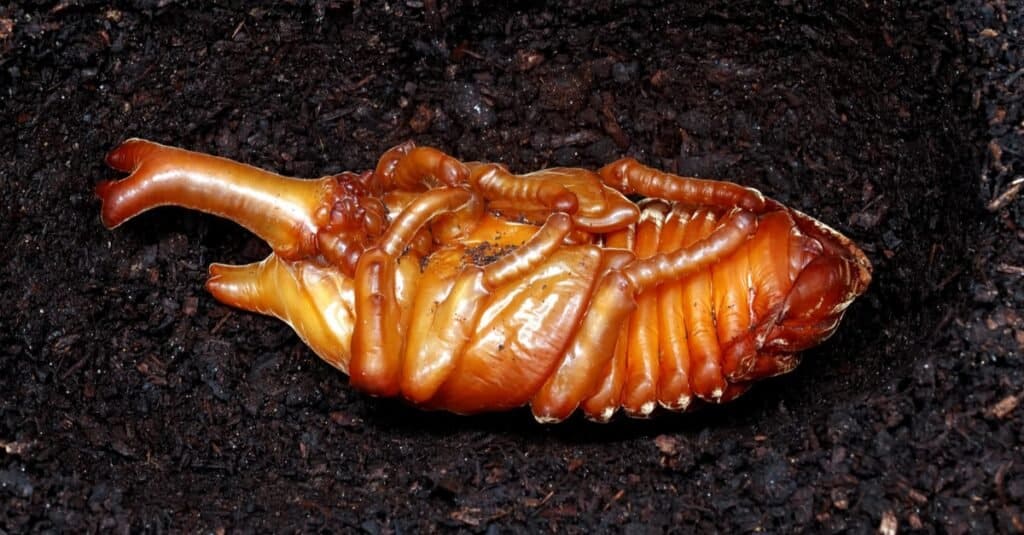
©topimages/Shutterstock.com
When it’s ready to transform into an adult, the larva will find a secluded area of its habitat (usually by burrowing underneath the ground or hanging from a branch) and enter the pupa stage, also known as the chrysalis or cocoon. The pupa has specialized transformational cells that slowly mold parts of the body into adult shapes. The time it takes can vary by species. Some beetles take only a few weeks to transform, whereas other species take a few years. During this time, the pupa does not eat at all. Instead, it remains in a dormant state of reduced activity.
Depending on the behavior of the subspecies of beetles, the pupa can mature in a week o ten days or last for months, especially if it has pupated during winter. Pupas are an easy prey for other insects, birds and small animals. If you are growing Beetles, then it is important to keep the pupa separated from the larvae as the larvae may eat the pupa. Once the beetle emerges from the cocoon, you may put it in a separate beetle bucket or area where they are fed and kept.
The Adult Stage

©Brett Hondow/Shutterstock.com
When the pupa stage is finally completed, the beetle emerges as a fully formed adult. This adult form, also known as the imago, tends to be the most diverse stage of the beetle’s life. The adults can come in many different shapes, colors, and sizes. Some species have a scorpion-like tail. Others have a huge horn on their head. Yet other species mimic wasps to fool predators into avoiding them. Many beetles secrete toxic or distasteful substances to properly protect themselves; they often have bright and conspicuous colors to warn away predators. There are many amazing facts about them.
Despite this immense diversity, beetle identification is fairly easy. The one defining feature of most beetles, as mentioned previously in the introduction, is the presence of the long wing covers along the back, which, when lifted up, enable them to fly through the air. Most species also tend to have a hard exoskeleton to protect them, but some types of beetles, including fireflies, are soft-bodied instead.
The main purpose of the adult stage is to reproduce with a mate. After the adults have performed this function, they usually perish a short time later. Most species do consume at least some food (its diet may change completely from the larval to the adult form), but there are a few species that don’t even bother eating at all. They rely on the energy gathered from the larval stage to survive until reproduction. The adult’s life expectancy can vary dramatically, from just a few weeks to more than a year. Generations tend not to overlap much. They cede way to the new generation almost immediately.
Next Up…
- House Beetles Identification: The Most Common Types of Beetles in Your Home: Know more about beetles that live in domestic environments.
- The Top 10 Largest Insects in the World: Insects are everywhere, some we see and some we don’t, however, these 10 insects are definitely going to catch your eye with their size.
- Rat Lifespan: How Long Do Rats Live?: One of the most despised pests of all, find out how a rat can live.
The photo featured at the top of this post is © Tomasz Klejdysz/Shutterstock.com
FAQs (Frequently Asked Questions)
How many eggs do beetles lay?
The answer to that question depends entirely on the species. Some females lay just a single egg at a time, whereas others can lay hundreds or even thousands.
What do beetles turn into?
Beetles transform into adult versions of themselves. This process is known as a metamorphosis. They don’t transform into anything else except another form of a beetle.
Does a beetle have a 3-stage life cycle?
Most beetles actually have a four-stage life cycle, not three stages. The pupa stage is a necessary part of the lifespan of the beetle so it to can complete the metamorphosis into a full-grown adult.
Do beetles sleep?
Yes, depending on their lifestyle and behavior, beetles can sleep during the day or the night.
What are beetle eggs called?
The egg phase of the beetle life cycle doesn’t have a special name. They’re just called the eggs.
Thank you for reading! Have some feedback for us? Contact the AZ Animals editorial team.



